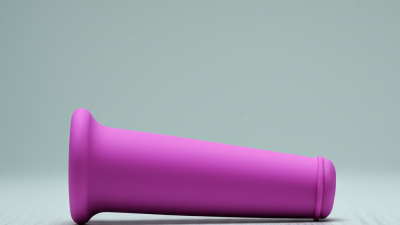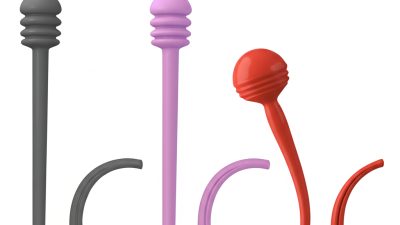Free Shipping on Orders Over $800 | Become a customer!
Menu title
This section doesn’t currently include any content. Add content to this section using the sidebar.
Your headline
Image caption appears here
Add your deal, information or promotional text
 The use of a Urethral Plug has gained attention in recent years as a therapeutic measure for various male health issues, particularly in the context of urinary incontinence and sexual dysfunction. According to a report by the National Institute of Diabetes and Digestive and Kidney Diseases, over 17 million men in the United States experience some form of urinary incontinence, prompting innovations in treatment options such as the urethral plug. While these devices can provide a non-invasive solution to managing symptoms and improving quality of life, they also come with potential risks that need careful consideration. A study published in the Journal of Urology indicates that while many users report satisfaction with the use of urethral plugs, complications such as urinary tract infections and discomfort can occur in a small percentage of patients. Thus, understanding both the benefits and risks is essential for those considering this option in their male health management strategies.
The use of a Urethral Plug has gained attention in recent years as a therapeutic measure for various male health issues, particularly in the context of urinary incontinence and sexual dysfunction. According to a report by the National Institute of Diabetes and Digestive and Kidney Diseases, over 17 million men in the United States experience some form of urinary incontinence, prompting innovations in treatment options such as the urethral plug. While these devices can provide a non-invasive solution to managing symptoms and improving quality of life, they also come with potential risks that need careful consideration. A study published in the Journal of Urology indicates that while many users report satisfaction with the use of urethral plugs, complications such as urinary tract infections and discomfort can occur in a small percentage of patients. Thus, understanding both the benefits and risks is essential for those considering this option in their male health management strategies.
Urethral plugs have gained attention for their potential benefits in managing male health, particularly in relation to urinary conditions. These devices can help alleviate symptoms associated with urinary blockages by preventing further irritation of the urethra, allowing for a more comfortable urinary flow. For men experiencing recurrent urinary tract issues or conditions such as benign prostatic hyperplasia, urethral plugs may serve as a no-catheter alternative, reducing the risk of infections and complications often associated with traditional catheterization.
Moreover, urethral plugs can potentially provide a more discreet option for managing urinary incontinence or overflow incontinence, offering a sense of normalcy in daily activities. By promoting proper bladder function and reducing strain during urination, these devices can contribute positively to a man's quality of life. However, an understanding of the risks, such as potential irritation or the risk of urinary tract infections, is essential for informed decision-making regarding their use in male health management.
The use of urethral plugs can present several potential risks for men's health, despite their intended benefits in managing urinary incontinence and other conditions. A study published in the "Journal of Urology" noted that improper insertion or prolonged use of these devices could lead to significant complications, including urinary tract infections (UTIs) and bladder injury. In fact, data indicates that nearly 15% of users experience some form of UTI related to urethral plug complications, underscoring the need for proper guidance and hygiene.
In addition to infections, men who use urethral plugs may face the risk of urethral strictures or injuries from the device itself. Research from the "American Urological Association" shows that about 5-10% of patients applying urethral plugs may develop strictures after prolonged use. It's crucial for users to be aware of these risks, as signs of discomfort or unusual symptoms should prompt immediate medical consultation. The balance of understanding these potential hazards is essential for those considering urethral plug usage, emphasizing the importance of professional oversight and patient education in ensuring safety.
When it comes to using a urethral plug, proper insertion and removal techniques are essential to ensure safety and comfort. Before inserting a urethral plug, it is crucial to prepare the area by cleaning both the plug and the genital region with a mild, non-irritating cleanser. Utilizing a sterile lubricant can greatly enhance the ease of insertion. Gently hold the penis and guide the plug into the urethra with a slow, steady motion, ensuring that you do not force it as this can cause injury. It is recommended to maintain a relaxed state during this process to facilitate smoother insertion.
Once the urethral plug has served its purpose, removing it should be approached with the same level of care. Start by washing your hands thoroughly and applying a suitable lubricant to the plug area. Gently pull on the retrieval cord, if available, or use a steady, but careful motion to extract the plug from the urethra. Avoid any sudden jerking movements to minimize the risk of damage to the urethra. After removal, ensure to clean the area again to prevent any potential infections, and always monitor for any unusual symptoms in the days following use.
| Aspect | Details |
|---|---|
| Benefits | 1. Reduces urinary leakage 2. Enhances sexual pleasure 3. Can aid in bladder training |
| Risks | 1. Risk of urinary tract infections 2. Potential for tissue irritation 3. Risk of improper insertion leading to injury |
| Insertion Procedure | 1. Wash hands thoroughly 2. Use lubrication on the plug 3. Gently insert the plug into the urethra at a slight angle |
| Removal Procedure | 1. Wash hands thoroughly 2. Relax the pelvic muscles 3. Gently pull the plug straight out without twisting |
| Aftercare | 1. Clean the urethra area with mild soap and water 2. Monitor for any signs of discomfort or infection |
| Consultation | It is advisable to consult with a healthcare provider before starting the use of urethral plugs, especially for individuals with pre-existing conditions. |
When using urethral plugs, maintaining proper hygiene is crucial to prevent infections and ensure overall health. First and foremost, always select high-quality urethral plugs made from body-safe materials such as silicone or medical-grade plastic. Before and after each use, ensure that both the plug and the genital area are thoroughly cleaned. You can use mild, unscented soap and warm water for this purpose, as harsh chemicals or fragrances may cause irritation.
Additionally, personal hygiene goes beyond just cleaning the plug. Regularly trimming pubic hair can help improve cleanliness and comfort when using urethral plugs. Consider using a sterile lubricant during insertion to reduce friction and ease discomfort. After removal, allow the plug to air dry completely before storing it in a clean, dry place. This will minimize the risk of bacteria buildup, ensuring that the plug remains hygienic for future use.
For men seeking alternatives to urethral plugs in managing urinary issues, several options are available that may offer benefits without the associated risks. One such alternative is the use of
pelvic floor physical therapy,
which focuses on strengthening the muscles that control the bladder. This method can help alleviate urinary incontinence and improve overall bladder function while minimizing invasive measures.
Another promising approach is the use of medication to manage symptoms related to urinary retention or incontinence.
Medications such as anticholinergics can relax the bladder muscle and reduce urgency or frequency, providing a non-invasive solution for many men. Additionally, lifestyle modifications, including maintaining a healthy diet, staying hydrated, and following a regular toileting schedule, can also significantly improve urinary health without the need for mechanical devices.
These alternatives not only prioritize comfort and safety but also promote long-term health outcomes.






We use cookies on our website to give you the best shopping experience. By using this site, you agree to its use of cookies.
